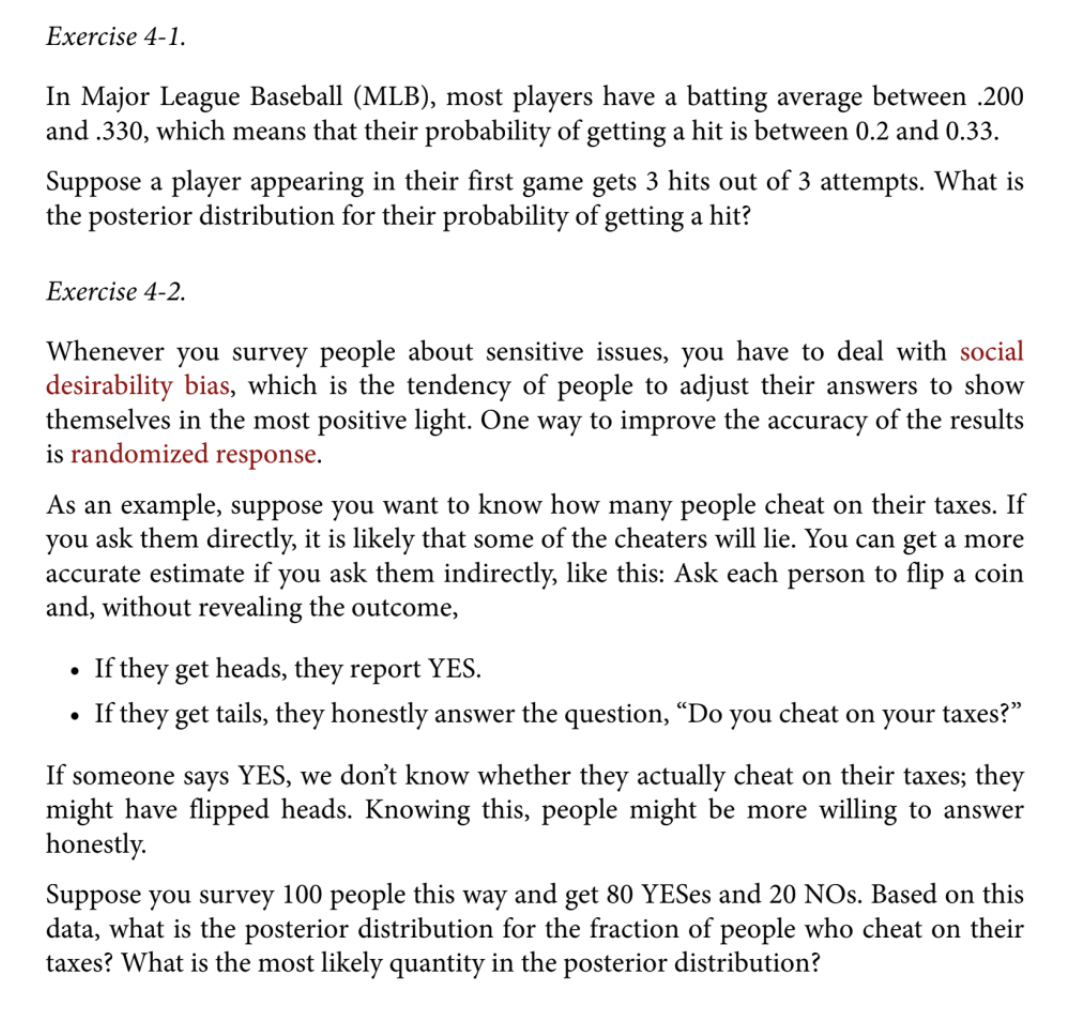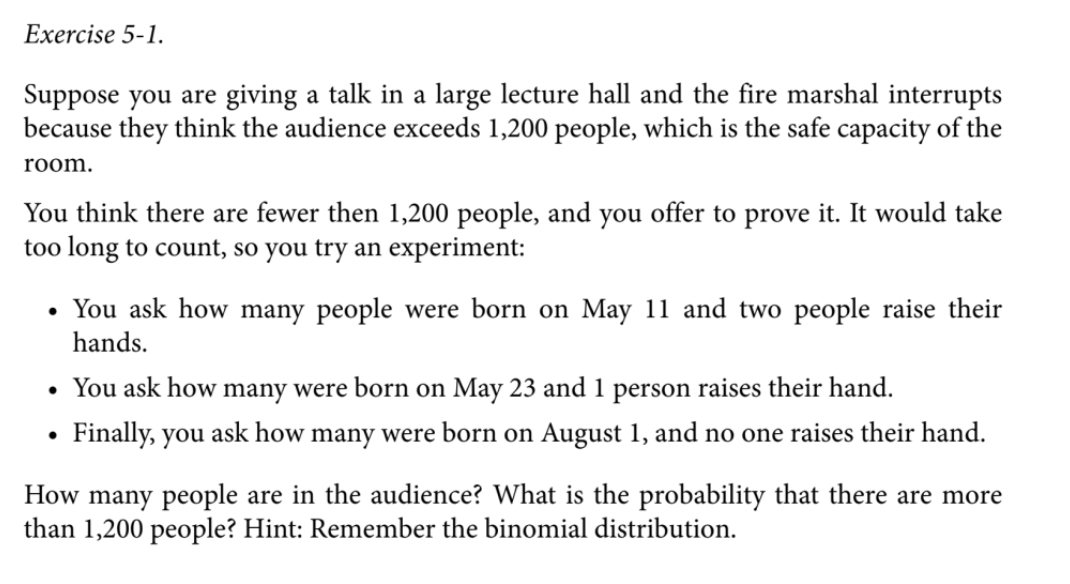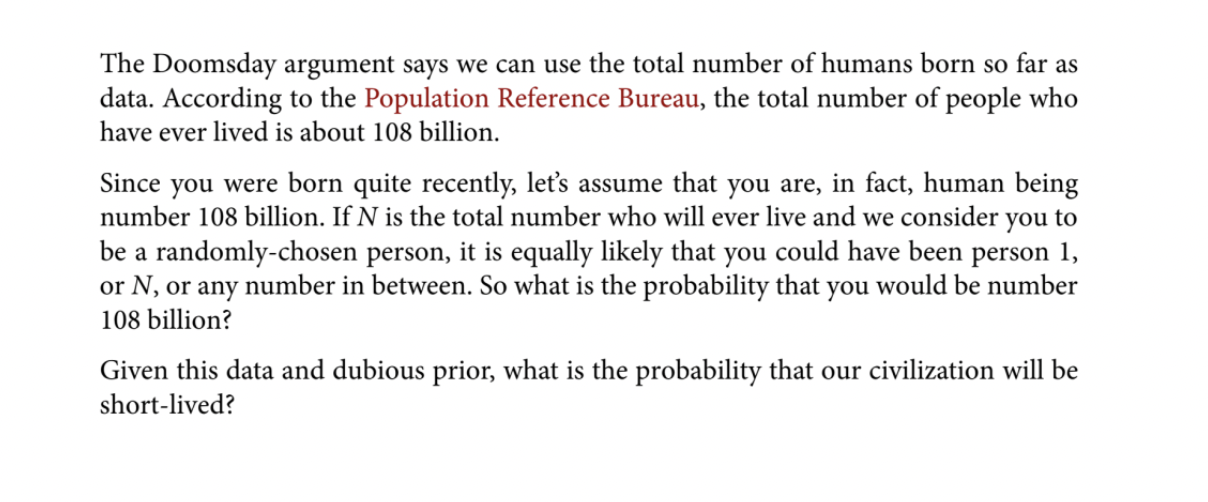Answered step by step
Verified Expert Solution
Question
1 Approved Answer
Exercise 4-1. In Major League Baseball (MLB), most players have a batting average between .200 and .330, which means that their probability of getting





Exercise 4-1. In Major League Baseball (MLB), most players have a batting average between .200 and .330, which means that their probability of getting a hit is between 0.2 and 0.33. Suppose a player appearing in their first game gets 3 hits out of 3 attempts. What is the posterior distribution for their probability of getting a hit? Exercise 4-2. Whenever you survey people about sensitive issues, you have to deal with social desirability bias, which is the tendency of people to adjust their answers to show themselves in the most positive light. One way to improve the accuracy of the results is randomized response. As an example, suppose you want to know how many people cheat on their taxes. If you ask them directly, it is likely that some of the cheaters will lie. You can get a more accurate estimate if you ask them indirectly, like this: Ask each person to flip a coin and, without revealing the outcome, If they get heads, they report YES. If they get tails, they honestly answer the question, Do you cheat on your taxes?" If someone says YES, we don't know whether they actually cheat on their taxes; they might have flipped heads. Knowing this, people might be more willing to answer honestly. Suppose you survey 100 people this way and get 80 YESes and 20 NOs. Based on this data, what is the posterior distribution for the fraction of people who cheat on their taxes? What is the most likely quantity in the posterior distribution? Exercise 5-1. Suppose you are giving a talk in a large lecture hall and the fire marshal interrupts because they think the audience exceeds 1,200 people, which is the safe capacity of the room. You think there are fewer then 1,200 people, and you offer to prove it. It would take too long to count, so you try an experiment: You ask how many people were born on May 11 and two people raise their hands. You ask how many were born on May 23 and 1 person raises their hand. Finally, you ask how many were born on August 1, and no one raises their hand. How many people are in the audience? What is the probability that there are more than 1,200 people? Hint: Remember the binomial distribution. Exercise 5-5. The Doomsday argument is a probabilistic argument that claims to predict the num- ber of future members of the human species given an estimate of the total number of humans born so far." Suppose there are only two kinds of intelligent civilizations that can happen in the universe. The short-lived" kind go extinct after only 200 billion individuals are born. The "long-lived" kind survive until 2,000 billion individuals are born. And suppose that the two kinds of civilization are equally likely. Which kind of civilization do you think we live in? The Doomsday argument says we can use the total number of humans born so far as data. According to the Population Reference Bureau, the total number of people who have ever lived is about 108 billion. Since you were born quite recently, let's assume that you are, in fact, human being number 108 billion. If N is the total number who will ever live and we consider you to be a randomly-chosen person, it is equally likely that you could have been person 1, or N, or any number in between. So what is the probability that you would be number 108 billion? Given this data and dubious prior, what is the probability that our civilization will be short-lived? Exercise 6-8. There are 538 members of the United States Congress. Suppose we audit their investment portfolios and find that 312 of them outperform the market. Let's assume that an honest member of Congress has only a 50% chance of outperforming the market, but a dishonest member who trades on inside informa- tion has a 90% chance. How many members of Congress are honest?
Step by Step Solution
There are 3 Steps involved in it
Step: 1

Get Instant Access to Expert-Tailored Solutions
See step-by-step solutions with expert insights and AI powered tools for academic success
Step: 2

Step: 3

Ace Your Homework with AI
Get the answers you need in no time with our AI-driven, step-by-step assistance
Get Started


